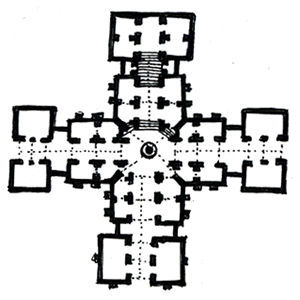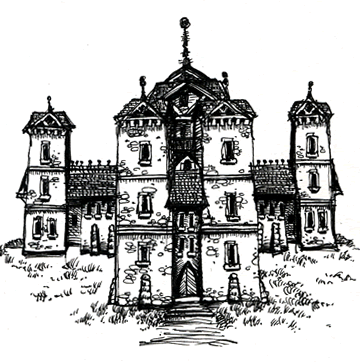|
The World of Teréth End - Religions - Dekàlan Gods |
||||||||||||||||||||
|
"Wulwur looked out upon the fields where his tenants stood, despairing their wilted crop. There would again be no harvest this year. The Valanian had noticed the shrines fallen into disrepair, many of the stones had been removed to repair fences and chimneys. They had sowed Kandlan's reward in the past and now would feel his wrath." Tome of the Golden Harvest |
Chapter Five - Kandlan Great Mother, Harvest Bringer, The Provider, The Quiet Goddess
Who is Kandlan? Kandlan is the goddess of life and reincarnation. She is the fertility goddess, granting children to the atoned barren, and raising high crops that produce plentiful food. She is known to many as the Quiet Goddess, for in no legends is she believed to speak. There are more shrines, Kandla, to Kandlan than any other god or goddess throughout ancient Dekàlas. Most farmers clear a small portion of ground and place three menhirs in reverence to the Bringer of Harvests. Some Kandla are very simple, while others can be quite elaborate. Historically, there has always existed animosity between the cults of Kandlan and Draun. Kandlan, representing the circular nature of birth, death, and re-birth is a preponent of reincarnation, whereas the cult of Draun feel that the realm of death is sacred, and should hold true, except by the will of the god of death. High level priests of Kandlan may be granted the spell Kandlan's Reincarnation. Draun priests do not reincarnate, preferring to resurrect the dead when the need and will of Draun dictate. Theologians have wondered at length how Kandlan managed this despite Draun's steadfast reluctance to open the necromancy sphere to any but its own aspects and faithful. Some believe the two, Kandlan and Draun, may be bound more intimately than each other admits. The Kandlan faith is also not popular among the followers of Woad. Whereas Woad represent nature and the natural process of things, Kandlan is a human god, representing humans' governance over the forces of nature. Agriculture is not appreciated by the faithful of Woad, and is seen as a destruction of the world's natural order. Woad's faithful see gardens as an abomination, an excercise of imposing human order upon the natural order. The Kandlan faithful are apprehensive toward the cult of Woad, as there have been many rumored incidents of Woad faithful destroying fields and gardens with fire, before the harvest so that the unnatural plants would die and the land could be reclaimed. Luckily for the Kandlan faith, the followers of Woad are few and poorly organized. The Divine Aspects Valania (the lifegiver) (Vuh-LAHN-yuh) (NG) appears as a beautiful ghostly woman that walks through the fields planting seeds. She carries a large satchel which she stops and studies before withdrawing each single seed and placing it in the ground. Valania is also depicted as planting seeds into the "stomachs" of women. Priestesses of Valania are chosen by virtue of their divine births. In areas where Kandlan-Valania are worshipped, whenever an illegitimate child is born a priest or priestess attends the child and mother. The mother and priest pray together until the father is learned. If it is revealed that the child has no father, the child is marked for the priesthood. The mark is placed on the hand of females, and on the forehead of males. Kandlan-Valanian priests hold a special place in the cult of Kandlan, despite their paradoxical impotence. Ir'Nil (the crone) (EAR-nil) (NE) appears as an old and withered hag that otherwise appears like Valania. Her "satchel of seeds" is worn and tattered like herself. Ir'Nil was does not pull seeds from her bag, but instead flies, maggots, rats, etc. Ir'Nil is the aspect of time passed, old age, putrescence, and plague. Ir'Nil is credited with plagues, pestilences, droughts, and famines. If she has followers they are few and keep to themselves. Many who do not understand the cult of Kandlan, believe that Ir'Nil exists in disfavor of the goddess. This is not true. The priesthood has been instructed (and some understand) that Ir'Nil's realm of decomposition and rot are instrumental in the cycle of rebirth. Priests of Ir'Nil however are rarely are welcome in civilized areas. A Kandlan-Ir'Nil temple is believed to have once stood in the city of Candal, but has long since disappeared. A few Kandlan priests claim to known where the foundation lies. The Priesthood Priests of Kandlan in many ways find themselves responsible for the well-being of their local communities and populations. They teach farmers the best ways to use their land, they serve as mid-wives, help maintain granaries, and generally make themselves indispensible in the places that they live. A common image and source of discussion within the Kandlan faith, is the three-rayed sun. Each sunbeam represents life, death, and re-birth respectively. Detailed renditions of the image show the first beam (the left ray) terminating in an open-palmed hand. The second beam (the center ray) end in a closed fist with thumb extended (Kandlan symbol of transient death), and the third beam (the right ray) end in an open-palmed hand with fingers splayed (Kandlan symbol of birth). This theme of three stages is repeated throughout the teaches and iconography of the Kandlan faith. A few that die in the exceptional graces of Kandlan are believed to be reborn ascendant (sometimes "transcendant"), never to be reborn in an earthly form. This is believed by many to be the ultimate gift of the goddess. (see Dresthar ) Day-to-Day Activities: The clergy of Kandlan serve as spiritual and instructional leaders. Their days are spent in the company of their "flock", answering questions and leading the faithful in daily prayers. Kandlan priests are notable healers and answer their calling when the faithful are needful. Priests of Kandlan observe a morning and an evening prayer daily, devoted to that specific day. The Dekàlan calendar is based upon the Kandlan organization of days, week, months, and years. In the Kandlan calendar, each day of the year has a separate name and should be welcomed and bid farewell with specific daily prayers. A few priests know all the prayers by heart, but most resort to prayer books. Holy Days/Important Ceremonies: Kandla are often stringed with ropes of flowers on Candala, the first day of Spring and first day of the new year. This is a festival day celebrated in areas throughout ancient Dekàlas to the present. It is customary in areas where a Kandlan priesthood remains, for a temple representative to visit each farm on Candala and give the family and the fields blessing on this holy day. The annual treks of these priest are something of legend themselves as they attempt to reach all their faithful within a given day. Candala is celebrated by many people that do not worship the goddess Kandlan, as it falls on the first day of each new year. Most notably, Amrans are notorious for holding grand parties, balls, and festivities on Candala, to the displeasure of the cult of Kandlan. The Kandlans are not opposed to many festivities and celebrations, but dissapprove of the lustful and decadent pursuits of many Amran faithful. Each seasonal marker is accompanied by a Kandlan festival. There is no specific spring festival, though some consider Candala to be a seasonal holiday. The summer festival, Athahda (ATH-thuh-DAY), is also referred to as the Festival of Youth. The autumn festival, Serdùrrun (SEAR-duhr-uhn), is the Feasting Day. Serdurrun requires that all faithful bring foods for a large communal feast. The final seasonal marker is Esthar, or Wintermeet. Esthar is the least festive and most solemn of the seasonal holidays. It is at Esthar that the faithful are reminded of the year past, and given chance to atone in this last season for that which they did not do to please the Goddess. It is believed by many of the faith, that those that do not please the Goddess, or do not atone for their failings of the year passing, perish in the cold clutches of winter. Those that die in the Kandlan faith during winter months are Dresthar, or winter-dead. The dresthar are not reborn, having fallen from the graces and cycle of Kandlan. Major Centers of Worship: The Kandlan faith is centered in the "bread basket" of the Dekàlan Empire. The main Temple of Kandlan stands in the city of Candal on the northern shore of the Azalarean Sea. Lesser temples are built outside the cities of Anugth and Taládan.
The Temple of Candal was a massive sirkùlar garden divided radially into separate shrines for each of the twelve Dekàlan months. Within each month's region, the weather of that month was maintained around the year. Stepping into the Shrine of Lanal one might pluck ripe fruits from a walkside tree in the deepest winter months. The center of the garden is a sirkùlar pool surrounded by three large menhirs. A shining orb shone from the top of each pillar with the Light of the Three. Each light is believed to be a gateway to a separate ethereal-realm of light and timelessness. The pillars are believed to be unscalable. The Light of the Three were not extinguished by the Destruction of Ildûn, although the explosion laid waste to much of the ciry of Candal. Since that time, the Garden has slowly recovered. The central pool has remained murky, though some claim to have seen the murk disperse in areas and viewed distant faces and figures beneath the surface. Only priests of Kandlan are allowed near the pool. The Inner Circle is guarded constantly by twenty -four templars in a golden plate armor. It is not known whether the guards are human (or for that matter mortal), for at dawn and dusk they change guard by marching to and from the monthly shrines, and are never seen without their armor.
The cult of Kandlan is ruled by a body of three high priests (heirophants) that govern over the workings and directions of the cult. It is believed that in important times, the Kandla sirkùli may call upon the Goddess and her aspects and receive direct audience. Each high priest belongs to a different facet of the cult: 1) Kandlan, 2) Kandlan-Valania, and 3) Kandlan-Ir'Nil. Spells of the Faithful D&D Spells:
GURPS Spells: The
Davra Orkid available to Kandlan spellcasters is: Body
(F3), Divination (F1), Elemental
Earth (F2), Elemental Fire (F2), Enchantment
(F2), Food (F2), Manipulation
(F1), Meta (F2), Mind
(F1), Movement (F1), and Wards
(F2).
|
Navigation Dekàlan Gods There are ten major gods traditionally worshipped by Dekàlans. Amra (beauty, love) Other gods have emerged in the same lands since the fall of Dekàlas. While some are new, some ancient deities have experienced a resurgence of faith. Eiron (law, duty) Domains Spellcasting clerics of Kandlan have access to the following domains Earth Worshippers of her aspects have access to different domains. Valania's priesthood have access to
while Ir'Nil's priesthood has access to Air |
||||||||||||||||||
|
Ref. PHB (Player's Handbook), DF (Defenders of the Faith), FR (Forgotten Realms Campaign Setting), KK (Kingdoms of Kalamar Campaign Setting), © Wizards of the Coast  |
||||||||||||||||||||

